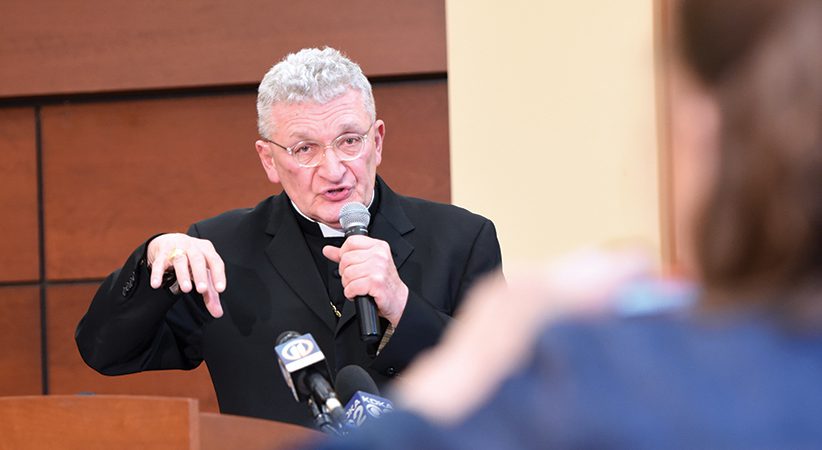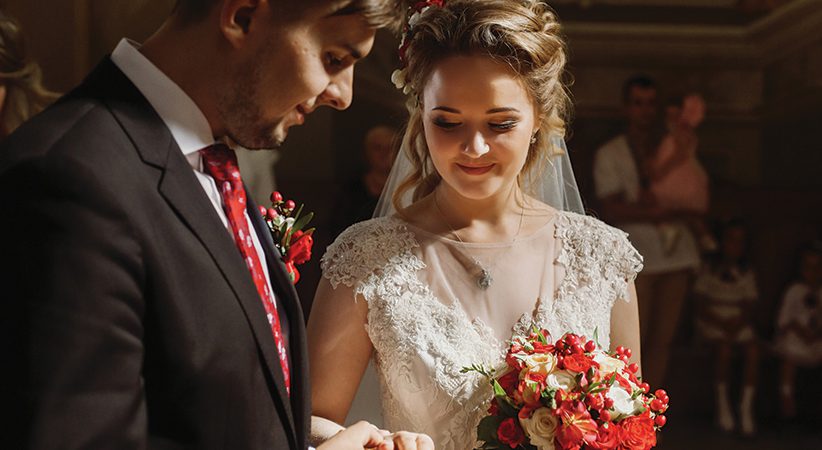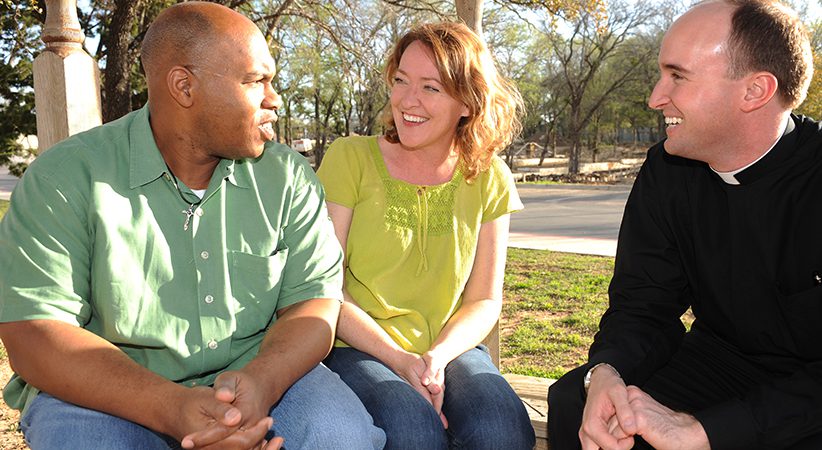Liturgy in the Time of Easter
An expert’s guide to celebrating Mass during this holy season
Father Paul Turner Comments Off on Liturgy in the Time of Easter
Sunday is to the week what Easter is to the year. That aphorism condenses the platform from which springs the Catholic Church’s complete understanding of time, according to the Universal Norms on the Liturgical Year and Calendar (No. 1). You can find these near the front of the Roman Missal. They serve as a signpost with an arrow labeled “You are here” at any point of the liturgical year.
Citing St. Augustine, these norms also call the 50 days of Eastertime one “great Sunday” (22). These days fill us with joy.
Easter Sunday
Bleary-eyed from the Easter Vigil, the priest usually arrives for Mass on Easter Sunday to the gratifying sight of a beautifully decorated church teeming with people dressed more formally than usual. Musicians have practiced especially hard, smiles abound and frequently even the weather cooperates to foster a spirit of celebration.
The Easter Sunday Mass has several unique features. For example, the Gloria returns after a six-week absence. It likely snuck in on the weekdays that celebrated St. Joseph and the Annunciation of the Lord, but its return on Sundays highlights this season from the beginning of Mass. The Gloria especially adds to the festive nature of the day when all sing a setting that they know well.
The Liturgy of the Word includes the Easter sequence. It would be good for the people to learn a version for singing.
In the United States, the renewal of baptismal promises may replace the Creed at Easter Sunday Masses. Although this renewal is not part of the typical edition of the missal, it is permitted — not required — throughout the United States. If you wish to make this adjustment, the missal has us turn back a few pages to find the appropriate formula from the Easter Vigil. This requires setting an extra ribbon before Mass begins. The rubric calls it the renewal of baptismal promises, implying that a sprinkling of blessed water also follows.
Apart from this Mass, people renew their baptismal promises on only a few occasions, such as the Easter Vigil or when an infant baptism is celebrated at Mass. The renewal is also part of the administration of viaticum. The sick person, knowing that death is near, is invited one last time to profess his or her baptismal faith. To include this renewal of promises on Easter day helps link the themes of baptism and resurrection.
Many parishes use the sprinkling rite from Appendix II of the missal in place of the penitential act at the beginning of Sunday Masses throughout Eastertime. The Order of Mass flags this option with a footnote at the penitential act (No. 4).
On Easter, however, if you’re going to sprinkle after the renewal of baptismal promises, you may want to keep a regular penitential act. In that case, if you use the third option, check out the various invocations in Appendix VI of the missal. These are not restricted to certain times of the year, but samples IV, V and VI are especially fitting for Easter. The appendix says “The Priest” leads these, but that does not overturn what the Order of Mass says: The priest, deacon or another minister, such as the cantor or reader, may lead the invocations (No. 6).
Additionally, you may compose your own invocations for this version of the penitential act, as the same number from the Order of Mass suggests. The examples offer a good model to follow: They do not impose an examination of conscience on the people; they praise the mercy of God.
For the Eucharistic prayer, the missal instructs us to use the first Easter preface. There are five of these, and any of them may be used throughout Eastertime, but the first is proper for Easter day. In the opening lines, you select the words “on this night” or “on this day” according to the hour of Mass.
If you offer the Eucharistic Prayer I, you use its special formulas in two places. Both of these come shortly before the institution narrative and consecration.
The first, introducing the section called by its Latin title “Communicantes,” praises God by noting that all are duly celebrating the resurrection of Jesus in the flesh. Again, you choose “night” or “day” depending on the hour of Mass. These words are found on a special page that groups these adaptations in sequential order according to the day or time of year. The last of them may be used on Pentecost Sunday.
The second altered formula, known as the “Hanc igitur,” plops the words directly within the proper place of this Eucharistic prayer. Throughout the rest of the year, your eye moves over them and onto the next section when you extend your hands over the offerings. But on Easter and throughout its octave, you offer this special paragraph instead of the one preceding. It alludes to the presence of the newly baptized among the congregation, implying that the neophytes have returned to celebrate another Mass after the vigil. Often I survey the congregation and see that our own neophytes have returned, but I like to use this formula because — who knows? — perhaps the neophytes from some other parish are in the church that day.
Near the conclusion of Easter Sunday Mass, you may use the solemn blessing from the Easter Vigil. This is an option, but a good one. To exercise it skillfully requires another ribbon set before Mass. People often do not bow down as directed, but all are supposed to make a low bow at the deacon’s command. Many of them don’t know that they are supposed to answer “Amen” to each section of the blessing, or when to say “Amen,” if they do know, because it’s hard to tell when the phrase has come to an end. Frequent use over time will make this go more smoothly.
The dismissal formula concludes with a double alleluia, whether it is led by the deacon or, in his absence, by the priest. It provides another restoration of this joyful word that has been suppressed throughout Lent. The chanted version that appears in the missal is quite lovely, and it is worth the effort to have the cantor and choir learn it well enough to lead the congregation. It’s good for the deacon and priest to learn it, too.
Easter Octave
The full week that follows Easter takes on a special character of celebration. We include the Gloria each day, though not the Creed. The Easter sequence may be sung each day.
The same preface from Easter Sunday is used, together with the words indicating day or night because the liturgy treats each of these days as another Easter day. The words “in this time” apply to the following weeks, but not to the octave. Note that we do not use prefaces II through V until the octave is over.
Whenever you offer the first Eucharistic prayer throughout the octave, you repeat the special formulas from Easter day, including the words that indicate that “this” is Easter. The octave treats each day that way. You may continue to use these formulas in the first Eucharistic prayer all week, including the Second Sunday of Easter (or Sunday of Divine Mercy).

The Gospels of the daily Masses this week present the accounts of the resurrection appearances of Christ, which are so key to our Easter faith. The Lectionary unfolds these in the order in which they likely occurred. Throughout the year, the Lectionary frequently offers its passages in semicontinuous order from a single book of the Bible, or in biblical order across several of its books. But the mixing of these Gospel passages for the Easter octave indicates another value: They help people celebrate the events of the Resurrection as they happened to the apostolic church.
In the missal, many of the penitential prayers this week make an allusion to the newly baptized. Look at all three of these on Monday Within the Octave of Easter for good examples. These refer to “new offspring,” “the Sacrament they have received,” “renewed by confession of your name and by Baptism,” and “those you have set on the way of eternal salvation.” Many other examples fill these prayers throughout the week, including its concluding Sunday.
The missal presumes that the neophytes are following an ancient practice: They return to celebrate the Eucharist every day for the entire octave. Some of the mystagogical catecheses still extant from around the fourth century were preached at the celebration of the Eucharist during the octave. These prayers were composed for the Church of the Middle Ages for the same purpose.
The previous English translation of the Rite of Christian Initiation of Adults said that the main setting of mystagogy is “the so-called Masses for neophytes, that is, the Sunday Masses of the Easter season” (No. 247). The revised translation of the Order of Christian Initiation of Adults more accurately states, “the principal place for ‘Mystagogy’ is the so-called ‘Masses for the neophytes’ or Masses of the Sundays of Easter Time.” These are two distinct sets of Masses. The first refers to the octave of Easter.
In practice, few parishes will get the newly baptized to attend every Mass of the octave. And you may not preach mystagogical catechesis each day. Nonetheless, the missal still provides the framework for all of that to happen.
These Masses may all conclude with the solemn blessing from the Easter Vigil. (Don’t forget to set the ribbon!) The dismissal formula uses the double alleluia each day through the Second Sunday of Easter.
Sundays of Easter Time
The following Sundays retain the spirit of Easter joy. The collects for these Sundays draw special attention to celebration. Look over these prayers and you’ll see that they include words such as “exult,” “youthfulness,” “rejoicing,” “joys of life eternal” and “days of joy.” They remind us week by week not to let the troubles of life overshadow Easter joy: Christ is risen indeed.
Some deacons and priests add the double alleluia to the dismissal formulas throughout Easter time, but the missal clearly gives other instructions. At the Easter Vigil, one of the last rubrics states that the double alleluia is added only throughout the octave of Easter (No. 69). It returns on Pentecost.
The first readings on these Sundays all come from the New Testament — the only time of year when we observe this practice. These readings form a miniseries of developments taken from the Acts of the Apostles. The developers of the Lectionary had a specific plan in mind for these readings. The second Sunday presents an account of life in the early Christian community. The third and fourth Sundays each year give examples of apostolic preaching. The fifth and sixth Sundays show the spread of the Gospel.
That was the design, but something happened just before the Lectionary was published. Year C introduced one exception: The account of Paul’s mission to the Gentiles, slated for the fifth Sunday in the Lectionary drafts, was moved to the fourth Sunday, and a new passage on the spread of the Gospel was added to the fifth Sunday in Year C. So, in Year C, we have an example of apostolic preaching on only one Sunday, and three subsequent readings devoted to the spread of the Gospel.
The second readings offer semicontinuous passages from three books that spread the joy of Easter: the First Letter of Peter, the First Letter of John and Revelation. The passages from Year C harvest from the Book of Revelation the vision of the heavenly Church at worship, skipping over the symbolic passages that allure so many people drawn to things apocalyptic. Instead, these excerpts lift our eyes beyond the celebration of Easter before us in real time to the one that awaits the faithful at the end of time. There we hope to take the best of our Easter celebrations and offer eternal praise to God.
Father Paul Turner is pastor of the Cathedral of the Immaculate Conception and director of the Office of Divine Worship for the Diocese of Kansas City-St. Joseph. His books include “Words Without Alloy: A Biography of the Lectionary for Mass” and “Sacred Times: A Guide to the General Roman Calendar and the Table of Liturgical Days,” both from Liturgical Press.





